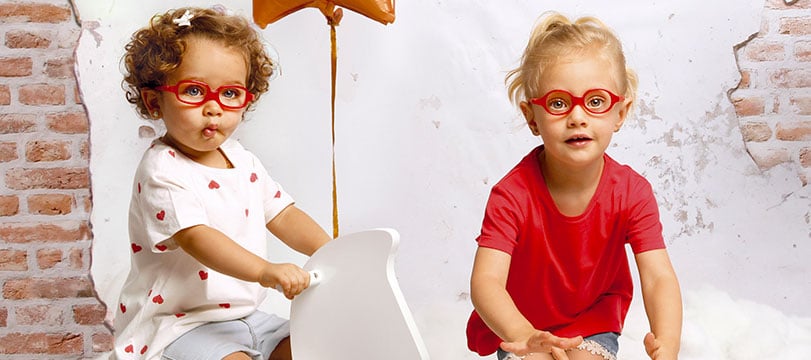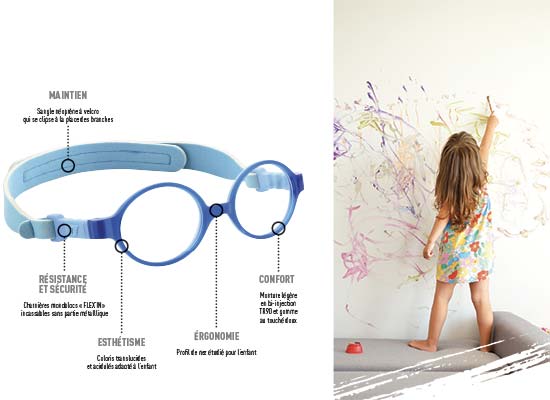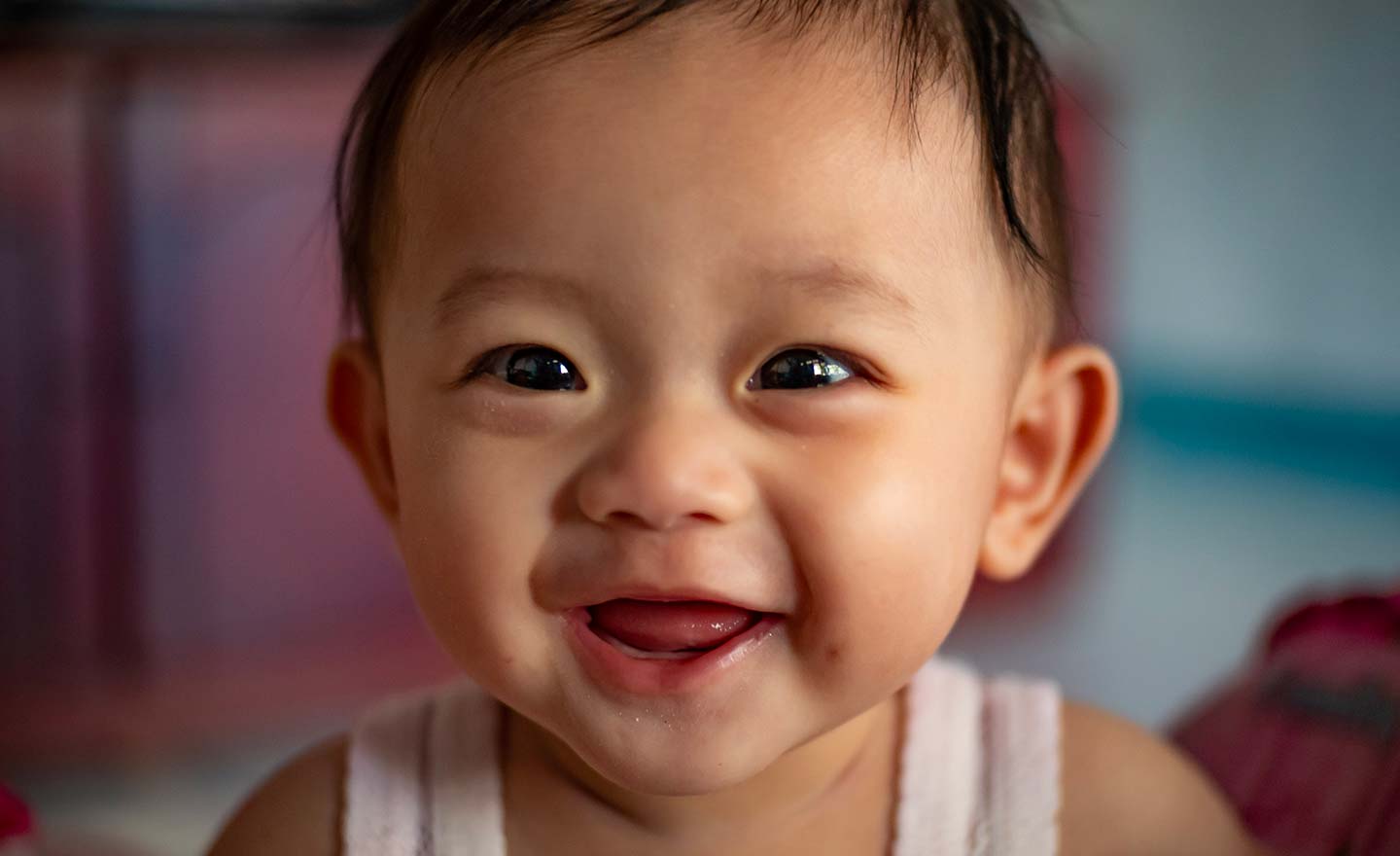
04:40 -
© Nanobaby-Nanovista
Sometimes even babies have to wear glasses. So what are the signs to look out for between the ages 0 and 3 years old? And how do you choose the right glasses for your baby? This is all the advice you need to take care of your child’s eyesight.
They might not yet be able to talk, but they can certainly see the world around them. Watching with constant curiosity, their vision builds step by step and impacts the rest of their development so to be sure that their vision is building correctly, it’s good to pay attention to their behaviour at each stage of development. A visual problem that’s taken care of early has a much better chance of being corrected, and in some cases, for some babies, that might mean glasses.
New-born babies have very weak eyesight (around 1/30). The world around them appears blurry and without depth. They can see just 30cm in front of them and only at the end of the first month are they about to see colors. Their eyes are very sensitive during this time so they need to avoid bright lights.
Over the weeks and months that follow, their vision builds step by step. Though during the first month, your new born won’t be able to make out all the details of your face, they will still be captivated by it and will watch it intently.
From the second month, they start being able to see objects that are close by. During this time, they begin to take more interest in their toys so start adding colored objects and different shapes to stimulate their vision.
At around 5 months, they are able to take hold of an object in their immediate surroundings and follow it with their eyes. After 6 months, they begin to gain hand-eye co-ordination and begin to recognise faces. At around 9 months, they begin to learn by imitation, reproducing facial expressions which will make them laugh a lot (and you too!). From 10 months, they can see and follow people and objects. Watch their behaviour throughout these stages of development to spot the slightest sign of visual abnormality that could mean they need to wear glasses.

© Nanobaby-Nanovista
If there is a family history, especially if both parents have sight problems, you need to be even more vigilant as there is a greater risk of offspring having sight problems too. “In a child of 0 to 3 years, there are certain signs to look out for,” explains Gilles Demetz, director-general of Demetz.
– “They rub their eyes a lot
– Their eyes stay still and don’t follow movements of things around them
– They furrow their brow
– They are visibly sensitive to light
– They hold their head strangely
– They are more and more cross-eyed after 4 months
– They blink nervously
– They are very clumsy when trying to pick up an object close by”
Throughout your child’s development, there are a series of tests designed to check their eye health, normally at birth, at around 9 months and at 2 years. But if you notice one of the above behaviours between two tests, make an appointment straight away with your optician.

© Demetz

© jonathan borba-unsplash

© Demetz
Your child might need to wear glasses from their very first months depending on the problem identified by your ophthalmologist, and the choice of glasses should be done with the help of an optician with plenty of experience in equipment designed for children. Glasses for babies are very specific and need to fulfil certain criteria. The frame needs to be comfortable and adapted to your child’s morphology and habits. “A child growing up in a world of adults will have a tendency to look upwards so the frame needs to be high enough so that they can’t look over the top,” explains Gilles Demetz. “They also need to have a low bridge to rest on the child’s small noise which will not be fully formed until 6 to 8 years old.” Babies’ skin is also quite fragile, so the glasses should not be too tight on the temples and they should also be well fitted so that they don’t slide.
“As for the material, it should be twist and shock-resistant and should not injure the child if they fall over. The frames need to be unbreakable, made from a flexible, hypoallergenic material. Monobloc designs are recommended for all babies and for older children, glasses can have a flexible hinge. Metal frames should be avoided until the age of 8 to 10 because these can cause injury if struck and the nose pads can be displaced more easily.”
As for the lenses, the director-general of Demetz advises that “the optician will recommend plastic with a strengthening treatment that will make them more resistant to scratches, and an anti-UV treatment as children have very transparent lenses and large pupils”.
In some medical circumstances, a baby may also be prescribed contact lenses. The ophthalmologist will make this decision and the baby’s parents will put them on and take them off.
How to get a baby to wear glasses?
It’s one thing realising your baby needs glasses, it’s another to get them to wear them. They need time to get used to their new face accessory and accept them, a time when you will have to be very patient.
But as they realise they can see better with the strange new object, they will soon come around. Encourage them, explain to them why they need them, even if they are very young. With time, they will pick up the habit of wearing them. Even then, keep checking that the glasses are fitted properly. As they grow quickly, they will need adjusting.
Glasses for babies come with an elastic band instead of temples to hold them in place, also useful for older children when playing sport.
For the first months, it’s possible that your baby will by cross-eyed from time to time. This is very common before the age of 3 or 4 because their eyes are not yet co-ordinated, and it should happen less and less frequently until it stops altogether.
But if it carries on after 4 months, get in touch with your doctor or ophthalmologist. If it’s caught in time, it can be treated, but acting quickly is important.

© reynardo etenia wongso unsplash
Whether your children need glasses or not, they need to protect their eyes from the sun. Choose sunglasses that cover a large area, especially on the sides. The lenses need to have a high protection factor against UV. Check for the CE mark: level 3 or 100% UV. If you are in the mountains in the snow, look for glasses marked level 4 or UV400. Glasses or not, babies should be kept in the shade and should wear a wide-brimmed hat. As ever, to be sure of having the right equipment, speak to your optician who will guide and advise you.
Written by Josh Arnold